There are all sorts of metrics to measure it, whether it be page views, time on site, or email open rates, but if we take away all the marketing mumbo jumbo, what is customer engagement and why does it matter?
Customer engagement is the strongest indicator of customers’ feelings about your brand. That’s right, we’re investing all this time and money into trying to improve something mushy gushy: feelings.
But really – feelings do matter. They’re one of the biggest factors in brand loyalty.
If people like your brand, they may come back to buy again.
If people love your brand, they’ll definitely pick you over competitors.
And if people can’t get enough of your brand, they’ll not only be dedicated to you but will spread the word to all their friends, too.
So, in short, engagement is our way of measuring customer sentiment in order to predict future loyalty.
Effective customer engagement strategies primarily consist of advocacy and involvement.
Here are our picks for the most effective customer engagement strategies that you should be using.
Show Personality in Microcontent
The best way to build continued customer engagement is through strong eCommerce branding.
Strong branding makes customers want to engage on an emotional level, which is the most long-lasting and strong connection customers can have with you.
Solid branding starts with excellent copy. Smart branding masters know how to leverage every copy opportunity to align with their messaging.
A great example of a company who builds engagement through branding is Chubbies. Chubbies’ playful and spot-on frat bro marketing has tapped into their Millennial market. And they don’t let any opportunity slip to integrate their voice into content. They infuse it into microcontent because they know the small details add up to make the big picture.

Another example of excellent microcontent copy is Warby Parker, who, despite tons of copycats, has still remained the industry leader because of their excellent branding.
Take a look at opportunities you may be missing – like buttons, CTAs, and more – where a touch of personality can reinforce your branding.
[Tweet “Solid branding starts with excellent copy.”]
Pair Requests with Rewards to Build a Positive Feedback Loop
People like to get something back.
Rewards and incentives like coupons or special offers can be paired with requests for reviews or other user-generated content to double the customer engagement impact.
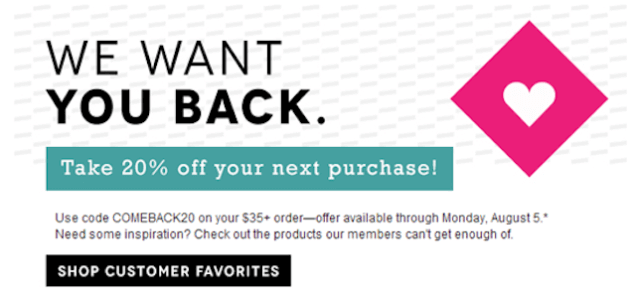
Birchbox does a great job of retaining its customers by offering rewards to previous purchasers. They not only offer a 20% off coupon off their next purchase but include a link to customer favorite products to shorten the path-to-purchase.
Why we recommend this customer engagement strategy: Not only will customers return to your store to redeem their coupon, but they will also feel a better connection to your brand after leaving a review for it.
How to implement this strategy: Use the Yotpo coupon feature for after-purchase rewards or pair it with our mail after purchase request.
Share Customer Reviews on Facebook, Twitter, and Linkedin
When you think of engaging content, reviews may not be the first thing that comes to your mind.
But customer reviews are a powerful way to re-engage current customers while also increasing your eCommerce conversion rates from social and raising brand awareness.
Why do people like to interact with customer reviews? For one, people can relate to content written by real customers more than brand messaging.
Honest reactions from their friends, family and social connections are more warmly received than generic branded content.
Additionally, adding customer reviews to social channels increases on-site engagement.
Adding reviews to Facebook boosts customer’s time on your site by 9.9%. And adding reviews to Twitter boosts time on site by 35%.
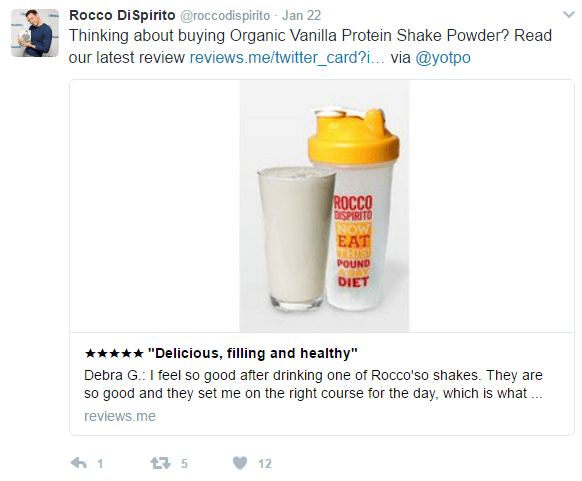
Rocco Dispirito, a world renowned chef, implements this strategy as well as anyone on social media. He consistently shares his reviews on Twitter that are broadcasted to his 400+ thousand followers.
Why we recommend this customer engagement strategy: Review traffic is more engaged than many of the other leading traffic-driving channels.
How to implement this strategy: Integrate your reviews with your social platforms to enable easy uploading. Connecting reviews to social ensure that you are seamlessly able to show off all your awesome 5-star reviews
Boost Post Sign-up Engagement with Gamification
Gamification is one of the most useful ways to boost long-term engagement, and one of the best times to implement it is after customers sign up. This onboarding phase is a time ripe for establishing how customers will feel about your brand. Here are some ideas:
- Use a progress bar during sign up to keep new users engaged

- Create leadership boards to ignite competition among new customers
- Infuse standard post sign-up emails with challenges and rewards for continued participation
Why we recommend this customer engagement strategy: In addition to boosting engagement, gamification also builds customer loyalty. By introducing gamification right when customers are introduced to you, you increase the chances they will be engaged, loyal customers.
How to implement this strategy: Think of new, innovative ways to keep customers engaged with your brand or even fellow shoppers. The only thing shoppers like more than a challenge are the rewards at the end of it.
Connect Customers Through Social Q&A
In the brick-and-mortar days, customers could ask both store workers and other shoppers their opinions about a certain item before buying. That customer experience has been preserved in the digital age through social questions and answers.
Allow customers to ask questions and provide answers based on personal experience. This not only provides them with reliable, real-time responses, but it also fosters their sense of connection to your brand.
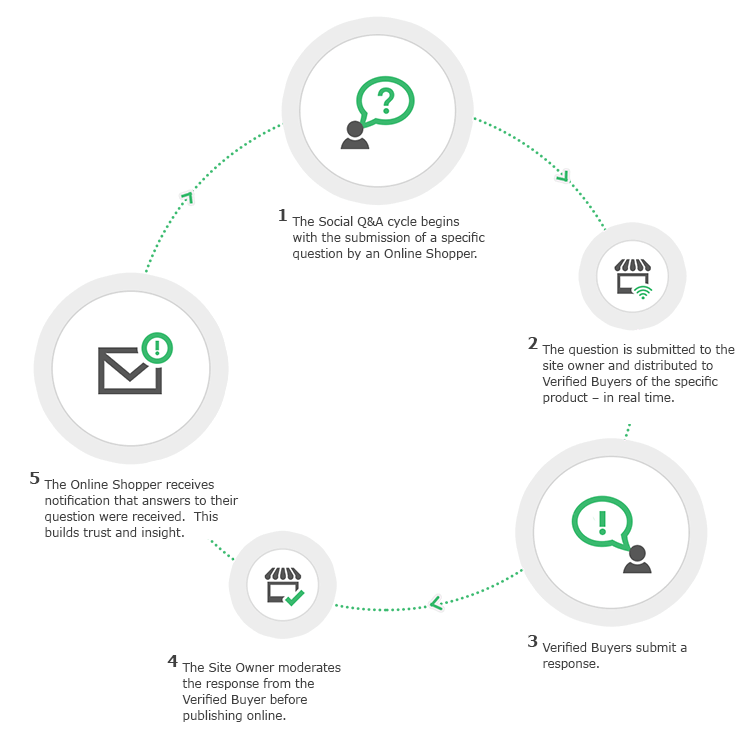
The example above shows how the lifecycle process works for social Q&A. As you can see, including verified buyers who were happy with their purchases in the process creates social proof around both your products and your eCommerce businesses alike.
Additionally (and most importantly) it brings them back to your store, putting you back at the forefront of their mind.
Let’s say they receive an email from your store and push it to the bottom of their inbox. A few days later, they get an email that a fellow shopper wants to know what they thought about a pair of shoes they recently bought from you.
They open the email and respond to the customer, and remember how much they loved wearing the shoes at their sister’s wedding.
This is an example of a way to keep your customers connected through customer-to-customer engagement, rather than brand outreach.
Why we recommend this customer engagement strategy: Customer responses to create a sense of connection and social proof around your brand
How to implement this strategy: One of the many Yotpo retention features is the ability for Social Q&A to be easily implemented onto your eCommerce website.
Use the Scientific Method to Optimize Headlines
Clickbait headlines are so last year. When crafting headlines for on-site content or subject lines for emails, it’s as important to grab your customers attention as it is to deliver.
Your headlines shouldn’t just be wild guesses – they should be data-backed blockbusters. Get scientific and A/B test headlines. But don’t stop there – test to see not just how headlines impact clicks, but engagement.
Remember, on average, only 20% of people who see a headline will click, so it’s important not just to make it clickable, but make it relevant.
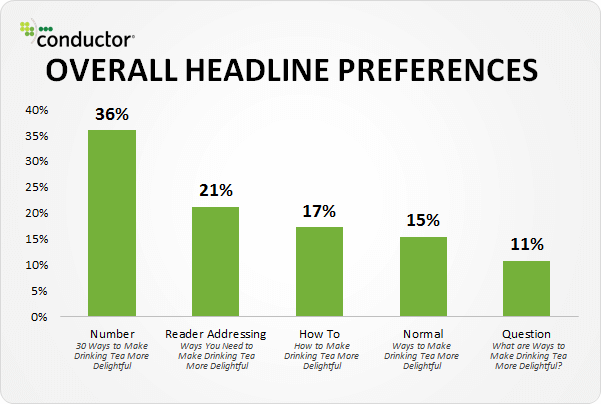
A study done by Conductor revealed that headlines that include numbers are 15% more preferable to readers than the next leading headline preference. During critical decision points such as deciding on headline titles, let science drive quality, high-intent engagement
Why we recommend this customer engagement strategy: Readers oftentimes decide whether or not to read an article solely based on the headline alone. We don’t want your great content to go to waste.
How to implement this strategy: Brainstorm multiple headline possibilities, and collaborate with team members and coworkers on which title stands out from the rest.
Encourage Brand Advocates to Become Community Leaders
Your most engaged fans may follow your brand regularly on social media.
Although already engaged, these are the most important customers to build relationships with. Done correctly, these brand fans can become powerful brand advocates who can create viral engagement through word-of-mouth advertising.
Building a customer community is one of the most effective yet often overlooked ways to increase long-term engagement. There are many customers who may not show their loyalty through repeated purchases but are great brand advocates whose word-of-mouth referrals bring you new traffic backed by the trust of social proof.
So how do you find and reward these brand fans?
- Start on social media. Find customers who are re-sharing your posts consistently.
- Start conversations with them to begin a relationship, and consider other ways you can leverage their passion for your brand.
- Add coupons on social media pages to reward customers who actively follow you. You can then see which customers redeem these coupons and reach out to them with follow-up offers.
- Think about how to get your brand fans to work for you.
For example, Free People knew their fans were the best people to write for their blog because they knew exactly what their target audience was interested in. So, they had their biggest fans write on their blog and ended up with highly engaging content.

Why we recommend this customer engagement strategy: Having customers who are passionate about your brand spread that message to others is a metric with boundless potential.
How to implement this strategy: Reach out to as many brand activists as you possibly can. Leverage social media, positive reviews, and any other platform you are able to identify happy customers.
[Tweet “Think about how to get your brand fans to work for you.”]
Surprise Customers With Ultra-personalized Outreach
We all remember the joy we used to get when our favorite restaurant or store mailed us a coupon on our birthday.
Today’s technology allows digital marketing to take this personalized engagement many steps further.
People are constantly overrun by content and customer marketing slogans. There are many strategies for standing out, but the most effective is simply to offer something surprising to customers, something that they don’t expect.
Enchant them with your ability to offer real-time, personalized deals and content marketing. A great example of this is Taco Bell’s location-sensitive specials. The surprise and personalization made it relevant to customers right when they needed it.
Why we recommend this customer engagement strategy: By personalizing outreach across digital marketing platforms, customers feel as though the advertisements were made for them. This personal touch cannot be overlooked when strategizing how to effectively target your audience.
How to implement this strategy: Create marketing and advertising campaigns based on location, social platform, and specific products when looking to boost your consumer engagement strategy.
Run Collaboration Contests for Product Inspiration
Ask your customers for opinions on your current product as well as future ideas. You’ll be surprised at just how willing they are to give their insight, and in doing so, become engaged with your product and brands. Here are some ideas for collaborative contests to get product feedback.
- Offer rewards for creating their own versions of your product. Domino’s Pizza Mogul campaign offers customers who design their own pizza a slice of the profit pie. Customers are invited to make their own pizza and then share and sell their recipe on social media.

Why we recommend this customer engagement strategy: Collaborating with customers allows them to feel a part of the buying process. They feel a sense of ownership to seeing your company succeed, which is one of the main reasons we love this strategy tactic so much.
How to implement this strategy: Crowdsource product ideas like Lego and Dell have done, or run tried-and-true techniques such as polling your customers or running surveys.
Make Customer Service Omnichannel
Today, we’ve all got digital fever and often forget that to rise above the noise and stand out, it may just mean going back to the basics. An omni-channel strategy rises above social media platforms; you can use traditional customer service methods to stand out.
- Build up real, long-lasting engagement by talking to your customers. Call your clients for in-depth conversations. Learn who they are, not just what they want to buy. This can give you valuable insights into what they really want.
- Put extra attention into unhappy customers. It may be tempting to simply send an automatic response to unsatisfied customers, but the best company knows that putting the most effort into these customers gets the real rewards. The best customers are those who have problems that are resolved, not those who have never had a problem.
- Instead of sending online communications, experiment with sending good old-fashioned snail mail coupons and catalogs.
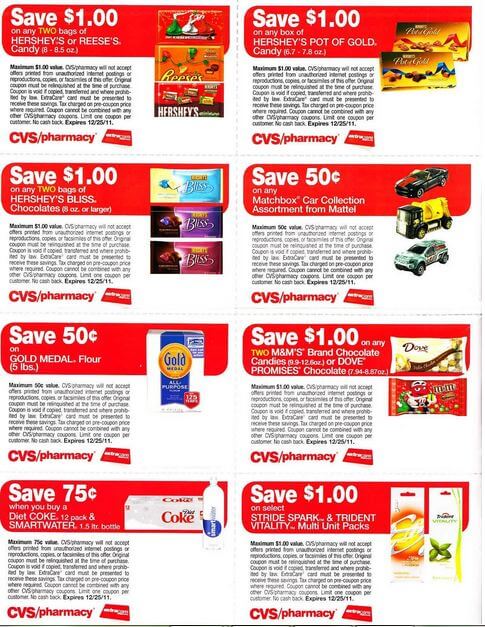
Why we recommend this customer engagement strategy: By being available to your customers through all available channels, you ensure to never miss an opportunity to impress or delight.
How to implement this strategy: Combine traditional customer service methods with new-age technology. Have a great coupon idea? Great! Send it with a Mail After Purchase form for incentive to review the product your customer just bought.
Conclusion
There you have it – the top new customer engagement strategies to help you get customers connected with your brand. If you have any more to add, we’d love to hear. Add your ideas in the comments below.






